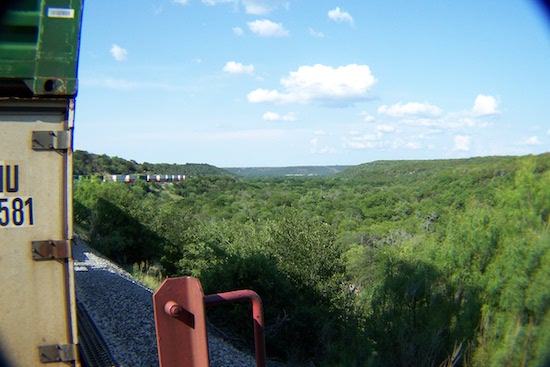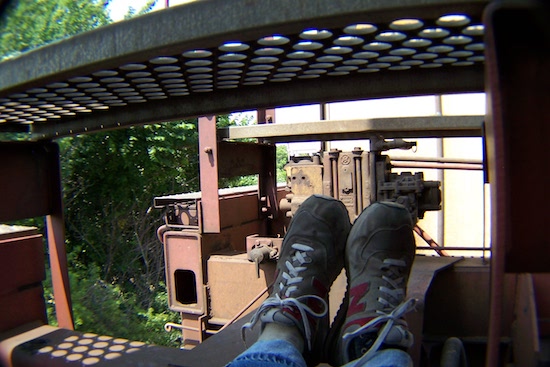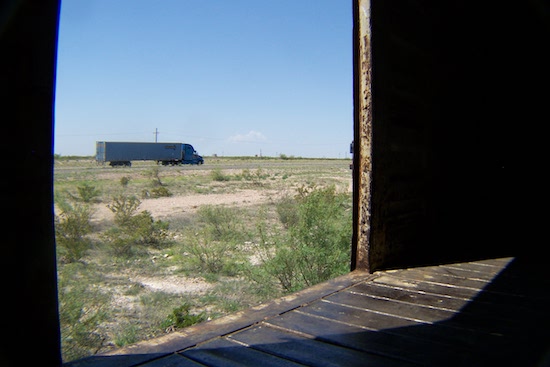Photos courtesy of Jeff Ferrell
Jeff Ferrell’s Drift, a stylish study of the idea and realities of vagrancy, takes the form of a sandwich. Opening and closing with extended meditations on the theoretical, aesthetic, political and practical significance of the concept of “drift”, its middle section offers a record of Ferrell’s personal experiences train-hopping across the Texan desert. This multifocal perspective lends a compelling sense of atmosphere to a work which insists on its subject matter’s resistance to conventional sociological research. The result is a readable and timely fusion of academic study and social reportage.
The desire to produce sociological accounts of those who wish, or are forced, to stand outside of mainstream society is not a new one, and among Ferrell’s many progenitors, Jack London stands out as one prominent figure. Author of 1903’s work of incognito social investigation The People of the Abyss, itself a key source for George Orwell’s Down and Out in Paris and London, the prolific London was born in San Francisco and wrote a series of works whose texture is that of the American road. Key for Ferrell is London’s self-fashioning: however much his experiences of displacement and drift may have been the product of his historical context, London always conceived of himself as a drifter first and foremost. As Ferrell quotes approvingly from 1907’s The Road: “I became a tramp – well, because of the life that was in me, and of the wanderlust in my blood that would not let me rest.” This is a self-fashioning that renounces its status as such – not so much a jacket one wears, as the skin one is in.
London’s claim at authenticity clearly resonates with Ferrell, who approaches his subject as a vocation. Drift is stocked with profuse reference to his earlier works on related themes, and although the bracketed, mid-sentence citations sometimes make for a frustrating read, threatening to break the flow of his otherwise lucid analysis “(see Ferrell 1996, 2006, 2013; Ferrell, Hayward, and Young 2015, 213–14; Ferrell and Weide 2010)”, they also testify to the long gestation of Drift as the product of a career spent thinking critically about sociological and criminological study. Ferrell’s intricate and stimulating discussions of “drift dialectics”, “contexts”, “politics” and “method” are clearly the products of extended and idiosyncratic thought on this subject.
It is really in the book’s middle section, with Ferrell’s his journey across Texas that the study gets into its stride. Subtle shifts in register – increasingly clipped sentences and the deployment of specialist argot – betray his enthusiasm for the train-hopping experience. The differences between riding “clean face” and “dirty face”, the significance of the “cheese grater” and the coded “sign-in” messages left by train hoppers, all form tantalising insights to the otherwise obscure other-world of long-distance logistics. Poignant in their apparent uselessness, the notes that Ferrell’s friend and subject Zeke appends to his sign-ins, appealing for information about his lost dog, are one example of the personalised and emotive insights afforded by Ferrell’s practice. The whole sequence becomes an apt demonstration of what he terms, in a pleasing near-oxymoron, the “intense ephemerality of drifters’ communities”.

Drift is highly attuned to the rich stream of Americana that its title conjures. Though Ferrell does occasionally mention “tramping”, there seems to be a profound difference between the dowdy British decrepitude that this calls to mind – as in the London section of Orwell’s Down and Out – and the idea of ‘freedom’ that is inseparably connected with the image of gleaming rails heading west. Ferrell tracks the roots of hoboism to the expansion of the railroads and the upheaval caused by the Civil War, tracing its connection with a specifically American form of capitalism and its demand for transient labour (‘hoe boy’ is offered as one possible root of the term). There is an infectiousness to Ferrell’s discussion, peppered with photos from Dorothea Lange’s 1939 An American Exodus, that is audible in his phrasing: “the rumbling thuds and booming train horns of the nearby rail yard echoing through my windows”. And there is music, too – not only Woody Guthrie and the whole topos of the Oklahoma ‘dustbowl’, but also unexpected agents of drift culture such as the 1909 Little Red Songbook of the Industrial Workers of the World (IWW), itself a volume whose portability helped sustain a whole culture of diffusely organised resistance.
Drift’s account of the immediate experience of vagrancy maintains an oblique and sometimes unexpectedly moving connection with wide-focus historical events. On one unsettling occasion, Ferrell recounts having found a cache of discarded objects clearly offloaded by a recent veteran of the Iraq war — four pairs of boots, as well as “desert camouflage uniforms, flashlights, guidebooks, maps of Al Fallujah”. Early on, he also offers up a theory of drift that sees it as characterising the present historical moment. The contemporary world, he claims, “is tracing a trajectory that is, oddly enough, defined largely by its insistent lack of definition. This is the trajectory of drift.” One is sometimes forced to wonder how true this is: if the present moment feels like a plateau, might its flatness not also be illusory – like a public pavement whose foundations have been hollowed out by someone else’s luxury basement cinema complex? The likelihood not so much of endless sameness, but of increasingly imminent cave-in, seems a more likely consequence of the connection that Ferrell makes not only between displacement and economic failure, but also with profit and growth. After all, as he notes, today’s laid-off rail workers could well be tomorrow’s drifters. Their shared knowledge of the trains’ inner workings makes the connection startlingly clear.

Ferrell is sensitive to the special freightedness, in an American context, of the ‘freedom’ supplied by drifting, while seeming himself to subscribe to some of its contradictions. He justifies his “Dumpster diving”, for instance, on the basis of “reasons of ecological intervention, charitable donation, and existential independence.” Zeke, too, offers his assent to an approach characterised by Jack Kerouac in The Dharma Bums, wherein it is “better to sleep in an uncomfortable bed free, than sleep in a comfortable bed unfree.” Doesn’t this doom drifting to an existence determined by the terms supplied by global capitalism, and more particularly on its logistical needs? Ferrell writes that “the distance that drift puts between the drifter and the social order is often a place of deprivation and despair but also a hard-earned space for critique and imagination”. Yet one might fairly contend that occupying a mode of existence that is always within the shadow of some other system precludes the possibility of dreaming a way out of that system. Looked at this way, the appearance of individual freedom is in fact something of a mirage. After all, one’s choices of where to go are not, strictly speaking, unlimited. The apparent arbitrariness of the “rumbling thuds and booming train horns” are in fact the time signature of a structure beyond one’s own control.
Drift nevertheless does a good job of revealing the unexpected gaps and loopholes in the system – the things that Michel de Certeau called ‘tactics’. One example is the “well” or “bucket” of the boxcar in which Ferrell and Zeke travel: this is formed by an apparently unlikely discrepancy between the length of the car and that of the two shipping containers it is built to hold. In an era of mass standardisation, one would hardly have credited the existence of such an irregularity. And Ferrell also offers some encouraging ideas of how, by embracing non- or anti-structural forms similar to those which prevent drifters themselves from being regarded as a straightforward, knowable object of traditional sociological study, groups like Critical Mass and Food Not Bombs have turned themselves into agents and models for social change as well as foils to the imperatives of the surveillance society that has sprung up around free-market capitalism. “Drift”, in Ferrell’s analysis, becomes here “not so much a head-on confrontation as an illicit disruption of the map itself.”
This is vibrant theorising, and given Ferrell’s open rejection of what he calls the “concrete slab” of conventional sociological methodology, it is striking that Drift is in fact immersed in deep reading and theoretical enthusiasm. The study builds on a substantial array of scholarship and reportage, accumulating catalogues of documentary evidence for its author’s observations, and he has plenty of use for selected morsels of theory like Deleuze and Guattari’s idea of the “rhizome”. The result, as it happens, is not so much estranging as invigorating. Ferrell succeeds in producing a stimulating sense of a rich and extensive topos for further investigation. Managing to drift without stalling or meandering, his study is a rewarding, sensitive and provocative piece of work.
Drift: Illicit Mobility and Uncertain Knowledge by Jeff Ferrell is published by University of California Press


